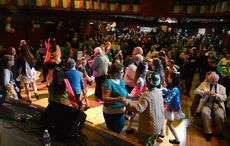Thousands of victims of Ireland’s Great Hunger remain buried under Staten Island’s modern structures in unmarked mass graves. Now, over 160 years later, the remains of some of those victims will be re-interred in a Memorial Green, part of the multi-million Supreme Court complex, in St. George.
Ships came in their thousands to New York City between 1799 and 1858 and every one of them stopped at Staten Island to be checked for infectious disease. Those passengers deemed infectious would be sent to quarantine at the Staten Island Marine Hospital, close to today’s ferry terminal, where they were held until they were healthy enough to continue their journey.
Sadly thousands, having left Ireland on coffin ships fleeing the Great Hunger, others fleeing political strife in Germany or elsewhere, died of cholera, yellow fever, smallpox, dysentery, and other infectious maladies.
According to Public Health Chronicles the hospital often treated up to 8,000 patients per year and in an effort to curtail the dangerous spread of disease they simply carried the dead from their beds to the grave. No death certificates were issued and no burial records were kept.
Their bodies were placed in trenches throughout the cemetery, near the hospital and also all the way up the hill on the 30 acre property, now stretching towards the Silver Lake Golf Course.
Lynn Rogers, executive director of the Friends of Abandoned Cemeteries of Staten Island (FACSI) said, “This facility simply couldn’t handle the volume of people dying. They also had 1850s mass emigration from Germany so the facility got slammed.”
Jennifer Hyatt-Morgan, a FACSI volunteer, transcribed the facility’s mortality schedule during an eight month period, selecting only the Irish. During that short period 650 died, according to the records.
Rogers said, “There’s two cemeteries. There’s the one that became the parking lot and there’s another one that today is a huge golf course and that’s where they buried the majority of them. There absolutely is thousands of bodies there.
“The reason they made the cemetery into a golf course in the 1920s /1930s is because there are just too many remains in there. There must be tens of thousands.”
By September 1, 1858, the residents of Staten Island had had enough of the disease and refugees landing on their doorsteps. Cara Dellate, Archivist at the Staten Island Museum, told IrishCentral, “Yellow fever was running rampant through the quarantine. People who were working there were getting sick and then bringing it home to their neighborhoods and infecting their own families and other people.”
An organized mob of Staten Island residents evacuated the facility and set fire to several of the buildings to fix their problem once and for all.
Over time the site of the hospital and the cemetery were developed, first with houses and then in the 1950s construction began on the site of the hospital's cemetery for a municipal park lot.
Rogers told IrishCentral that at the time local historian Marjorie Johnson knew what lay beneath the soil, however, there were no laws to stop construction.
Johnson, now 95, who went on to be one of the founders of the FACSI, followed a dumpster truck from the site. She witnessed the truck dumping human remains into New York Harbor.
Dellate had also heard this story. She said, “It is a pretty awful story actually when you really think about it. It really is a shame what went on back then, how people were treated and even in modern day. It was just in the 1950s. They must have seen them in the dirt and to just blatantly ignore it! It’s really sad.”
In the early 2000s New York State began their plans to build the new Supreme Court complex on the site. Having been made aware of the archaeological sensitivity of the site they began research. Over two years archaeological fieldwork was undertaken to define the boundaries of the cemetery and human remains were uncovered and taken to a laboratory for analysis by a forensic anthropologist. This research allowed them to plan the new multi-million dollar complex around the cemetery.
The human remains removed from the ground were separated into adults and children. Earlier this year Herb Smith, the owner of Meislohn-Silvie Funeral Home, in Port Richmond, retrieved the remains from the Park Slope, Brooklyn, lab.
Placed in two caskets, one for the adults, and the other a traditional white for the children, the FACSI, with the help of the Ancient Order of the Hibernians, provided a 19th century funeral service at St Peter’s Church on Staten Island.
The Church was specially chosen as it has a strong link with the quarantine facility having lost a number of priests the infectious diseases which plagued the area at the time.
Rogers told IrishCentral, “About 15 years ago they were re-decorating the Church and they found that a priest is buried under that altar with a plaque explaining that he had died administering to the Irish during the years of the Great Hunger at the quarantine.”
The caskets are now being kept at a receiving tomb in Moravian Cemetery, in New Dorp, and soon, once construction is completed on the Supreme Court building, they will be re-interred in a Memorial Green, in a quiet corner of the property, a place of quiet reflection, where the thousands buried from that period can be remembered.
The Friends of Abandoned Cemeteries of Staten Island (FACSI) plan to release a DVD telling the story of the area and these immigrants remains, by fall 2013. For more information on their group visit their Facebook page, call 917-545-3309 or email siccemetry@gmail.com.
Originally published in 2013.




Comments